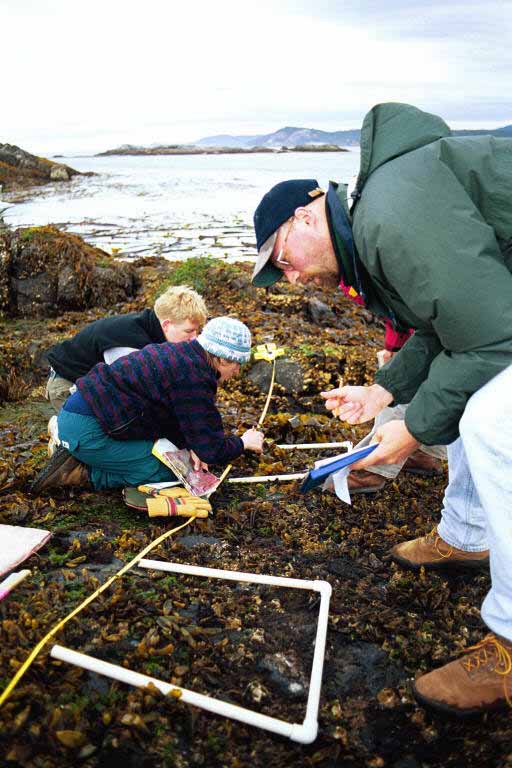THE OVERVIEW:
Images of transects applied to biological systems provide educators and students an opportunity to explore a wide diversity of systems and habitats. Traditionally, transects have been used in ecological studies to understand populations and community associations within selected habitats. The same concepts may be used to investigate any number of other biological systems ranging from individual organisms, or parts of organisms, to global ecosystems.
The transect provides a tool to focus attention on specific, selected systems and the effects of abiotic and biotic parameters affecting those biological units in the system. Qualitative and quantitative analyses by students at many levels, utilizing the resources of the world wide web, will provide the ability to study not only the specific transect site, but to link those studies with related research and information. It is our expectation that this exercise will not only provide an opportunity for an actual educational experience but will form the initial stimulus for contributions on new sites by other individuals and groups on a world wide basis. This would transfer the collaborative classroom exercise to a research activity reflecting the collaborative nature of international science.Educators and students are encouraged to use, among others, the Bio QUEST philosophy of collaborative learning to develop additional exercises that support the use of transects as a tool for biological investigations and learning.
QUEST philosophy of collaborative learning to develop additional exercises that support the use of transects as a tool for biological investigations and learning.
Collaborative Curriculum Lead-In:
Using the internet with biological transects can enhance knowledge and appreciation of important relationships in established biological systems. It is an ideal technique to foster and promote collaboration among students of a class, or between students from different geographic areas, the states or provinces, and countries. Teachers at all levels (K- 16) can take advantage of this medium to introduce students to the WWW as an information-providing tool, and as a research tool (example: NIH Image). Furthermore, they are encouraged to get their students to provide other examples of transects so that a transect data base on the web can be expanded. It could eventually include a wide variety of biological systems whether from a microscopic view point or a satellite perspective.
TECHNIQUES:
The basic premise of the initial transect presentations on this web site is of transects established linearly across a biological site (often through an environmental gradient). The measuring device used depends on the size of the site and the logistical constraints in putting it into place. It is envisioned that eventually transects ranging in size from a microscopic level to a satellite image level will appear here.
Note: to be useful for this project, all images contributed must have a reference measurement scale visible or the scale must be known so that it could be inserted into the pictures. Photos also need to be of good quality. It is also possible that accurate drawings could provide the image for a transect.
BIOLOGICAL SYSTEMS
Transects may be used in any biological system that is appropriate to the educational and scientific mission. What is presented here are suggestions for choosing habitats; the list is not all-inclusive, but hopefully a stimulus for further selection and development of sites. Most of our natural ecosystems in the world are being affected by the onset of Climate Change. If we are to know what the components of a natural ecosystem are , we need to document them before irreversible change occurs,
EXTERNAL SITES:
1. AQUATIC HABITATS:
a. Marine
- Water column (vertical and horizontal transects; use of satellite imagery)
- Rocky Intertidal
- Mud Flats
- Sandy Beaches
- Subtidal
- Cobble and Shingle Beaches
- Tide Pools
- Coral Reefs
- Thermal vent communities
- Ice Flow Communities
b. Estuarine
- Water column
- Mangrove communities
- Mud and sand flats
- Salt marshes
- Lagoons
- Docks and pilings
c. Fouling (Settlement) communities
d. Freshwater
- Lakes and ponds
- Ephemeral pools
- Rivers, streams and creeks
- Marshes
2. TERRESTRIAL HABITATS:
- Forest and woodland
- Grassland
- Savannah
- Chapparal
- Deserts
- Urban lot
- Agricultural fields
- Tundra
INTERNAL [LABORATORY BASED] SITES:
1. Microscopic communities: use of bacteria, protists, invertebrates, algae
- Petri dish populations
- Tissue culture populations
- Glass slide populations
2. Macroscopic habitats
- Aquaria – marine, estuarine and freshwater
- Terraria – desert to moist
We hope that this page will soon expand to include a wide range of images of very different transects. Some of the transects we would like to see contributed are :
-
- A transect through a bog ecosystem.
- A transect through an alpine ecosystem from the foot of a melting glacier.
- A transect through the shoreline of a drying salt pan as one sees in Saskatchewan or other locations on the North American Plains.
- Aerial transects from the tundra showing distribution of Caribou herds and vegetation .
- Aerial transects through the savannahs of Africa showing animal distribution patterns .
- Coral Reef and Mangrove Forest transects.
- Vertical Transects in Forest Ecosystems.
- Microscopic Transects.
HOW DOES ONE PREPARE IMAGES TO BE ANALYZED?
ECOLOGICAL NICHE MODELING: This file gives detailed instructions on the method used to download pictures for processing, measuring, and further work. It also contains details for an exercise on the 3D modelling of ecological niches of organisms.
ORIGINAL AUTHORS:
| This program was developed at the 1995 BioQUEST Summer Workshop on Collaborative Learning, Peer Review, and Persuasion in Biology Education at Beloit College, WI. USA The authors of the program were :
|
Peg 5 sample transects
See Transect A0050101
See Transect A0050102
See Transect A0050103
_____________________________________________________________
Return to the Contents page for Environmental modelling with Transects..

